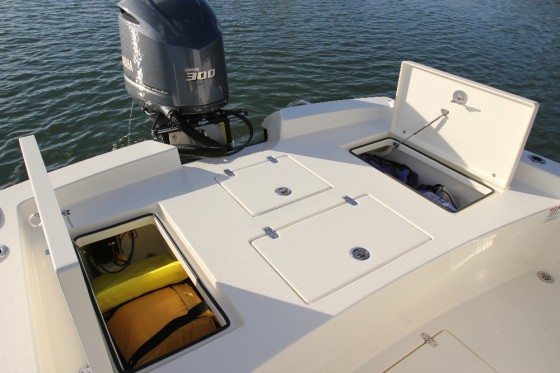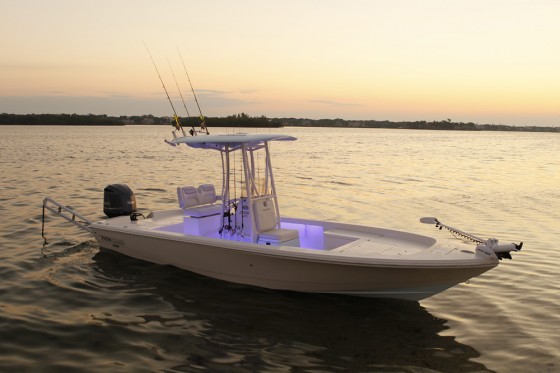Pathfinder 2600 HPS Bay Boat: All Hail the King
Pathfinder calls this new model the Bay Crusher, and after spending a day on this boat fishing in heavy seas, we say the name is appropriate.
It’s rare we test a bay boat, and find that it has each and every ideal trait we covered in Bay Boat Battles: What Makes One Better Than Another. It’s even more rare we decide to run a bay boat 10 miles outside of the inlet, and stay out there for hours. And it’s beyond rare that we’d do so on a day when it was blowing 15 knots and three to four foot swells were rolling through the ocean. Yet when we heard there was a hot bite going off we pointed the bow east, ran through the open sea, and fished out there long enough to catch a slew of cobia, bonito, and kingfish. Just how did it feel to be aboard Pathfinder’s 2600 HPS Bay Crusher? A picture may be worth 1,000 words but the video you’re about to watch is worth just one: awesome.
If you’re thinking the Bay Crusher had an unfair advantage over most bay boats in this type of offshore foray, you’re right. At 26’2” long and 3,350 pounds, this is one honkin’ big critter which pushes the limits of just what a bay boat is. Most boats of this genre are two to six feet shorter, and weigh significantly less. Yet size is just one part of the story here. The 2600 also has a unique 18-degree deadrise hull design that helps it handle those big seas, while still providing the shallow draft and fishing abilities inherent in the breed.
Fishing for Compliments
This hull sports twin steps—longitudinal notches which run from the chine to the keel on either side of the boat (for a full explanation of what steps are and how they work, read Stepped Hulls vs Traditional V-Bottoms: Everything You Need to Know). These steps boost performance by aerating the water running under the hull, and at the same time, flatten out the boat’s running angle. Standing on the deck as you tromp through rough seas, the ride is noticeably different than that of a standard-issue V-hull, and in this case, noticeably smoother.

Note the twin steps in the hull of the Pathfinder 2600; you won't find these, in your average bay boat.
Despite the Bay Crusher’s unusual design and size, it doesn't give up back-bay fishability. At 1'3" draft is still relatively low, the bow is pre-backed and pre-wired for installation of a trolling motor, the stern is ready for factory-mounting a Power Pole, and the list of fishing features is off the charts. Console rod racks, four flush-mount rodholders, an 80-gallon integrated/insulated fishbox, locking rod stowage boxes, 48 gallon (aft) and 15 gallon (bow) livewells, a raw water washdown, and an in-deck cast net stowage compartment are all standard features. Even a hydraulic jack plate with blinker switch, which would usually be a cost-adding option, is included on the 2600 HPS Bay Crusher.
Out in the ocean we spent most of our time fishing from the cockpit, but in calmer waters, you’ll probably be casting from the fore or aft decks. Both have large, flush, snag-free casting platforms and the cleats are pop-ups, so even fly anglers will find them accommodating. One added bonus of fishing from this boat can be spotted at the transom. The 2600 has a bump-out with the motor well built-in, so the engine rigging tubes are kept below deck-level where they’re always out of the way. And unlike some similar designs the well doesn't allow water to slosh in during sudden decelerations.

The aft casting deck is laid out perfectly for fishing, from the flush hinges to the transom bump-out.
Power Play
Of course, the boat’s large size will require some trade-offs. First and foremost will be cost, both initial and operational. The base model breaks $70,000 (at the time of this publication), and, especially if you upgrade the powerplant to a Yamaha F350, fuel economy isn't going to be quite as nice as it would be with smaller bay boats. That said, this boat is still pretty dang efficient. Even with that monster 350 horse outboard, economy over three miles to the gallon is attainable. Of course, that’s only if you can hold yourself back and set the throttle at 3000 RPM. Good luck with that. Opening it up and hitting speeds in the upper 50’s and lower 60’s is a heck of a lot more fun, and a tough temptation to resist—even if economy does fall below two MPG at wide-open throttle.
Another cost of the boat's size is transporting it. With an 8'10" beam, it's a bit wide for trailering down the highway. As far as handling goes, however, the size of the Pathfinder 2600 doesn't cost you a thing. The boat carves out hair-pins and leans into turns like any other well-designed bay boat. And since that jack plate is a standard feature you can pop up onto plane in skinny water, give the prop additional bite in tight turns, and give the stern more or less lift as conditions dictate.

Construction is all-composite, closed cell foam fills belowdeck voids, and phenolic backing plates secure mounts like those for the Power Pole and the electric trolling motor.
Crush and Run
| Specifications | |
|---|---|
| Length | 26'2" |
| Beam | 8'10" |
| Draft | 1'3" |
| Deadrise | 18 degrees |
| Displacement | 3,350 lbs |
| Fuel capacity | 79 gal. |
Another important factor to consider about the Pathfinder 2600 HPS Bay Crusher is the way it’s built, and this is a significant contributing factor to its big seas abilities. Think back to that video you just watched, of this boat running through the open Atlantic. Remember what you heard? Wind noise, water noise, and engine noise. What about vibrations, and rattles? Nada. That’s because the 2600 is put together about as ruggedly as any boat you’ll see in this class. One example: all of the hardware is backed with Phenolic plates. Layers of resin-impregnated paper and/or fiberglass are heated and pressurized to manufacture Phenolics, and the end result is an incredibly stiff, dense backing plate that can handle monstrous stress loads.
Another example of how well the boat’s put together can be found belowdecks, even though you can’t see it. Open up any of the stowage compartments or livewells, and rap your fist on the smooth, gel-coated liner. You’ll hear a solid knock, instead of a hollow sound. That’s because Pathfinder fills belowdecks voids with closed-cell foam, both adding floatation to the boat and deadening sound.
| Performance Data | |||
|---|---|---|---|
| Test conditions: Winds 15-20 knots, air temp 75 degrees, 2 POBPerformance data courtesy of Yamaha. | |||
| RPM | MPH | GPH | MPG |
| 1000 | 5.4 | 1.6 | 3.4 |
| 2000 | 8.4 | 4.9 | 1.7 |
| 3000 | 27.9 | 8.6 | 3.2 |
| 4000 | 38.7 | 12.9 | 3.0 |
| 5000 | 49.5 | 21.6 | 2.3 |
| 6000 | 61.9 | 33.7 | 1.8 |
| Power | Single Yamaha F350 four-stroke outboard, swinging a 15.5" x 19" stainless-steel prop | ||
Solid construction was, of course, just one of those traits we mentioned in that Bay Boat Battles article. As was hull design. Yes, you can also add fishing features, livewells, Power Pole anchoring systems, casting decks, and, well, the rest of the stuff we've talked about in the last 1,000 or so words, to this list. The bottom line? When bay boats do battle, the Pathfinder 2600 HPS Bay Crusher is going to come out a winner.
For more information, visit Pathfinder.

















